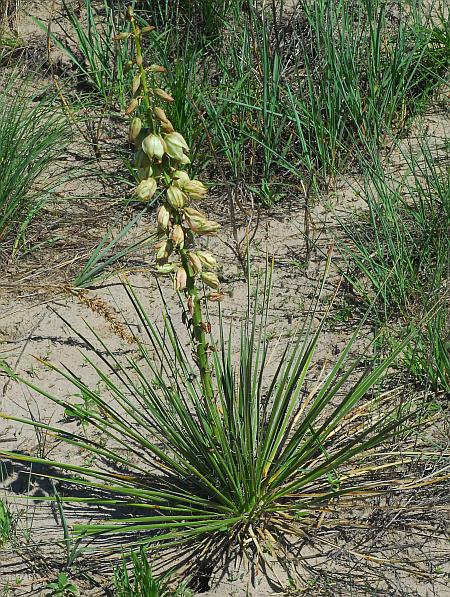Yucca glauca Nutt.
Soapweed

Native
CC = 10
CW = 5
MOC = 4
SRank = S2
© SRTurner
Yucca glauca Nutt.Soapweed | |
 |
Native CC = 10 CW = 5 MOC = 4 SRank = S2 |
© SRTurner |
|
Family - Agavaceae Habit - Perennial forb. Stems - Reduced to a persistent woody base.
Leaves - Basal, 8-40 cm long, 0.4-1.2 cm wide, somewhat glaucous, stiff and straight, leathery, linear with a short, narrow spine at the tip and white, peeling, fibrous margins.
Inflorescences - Racemes to 1 m long, erect or ascending, usually with a few short basal branches, short-stalked with the base of the flowering portion partially hidden by the leaves.
Flowers - Tepals 4-5 cm long, ovate-lanceolate, the tips sharply pointed, green or yellowish white, sometimes tinged pale purple. Stamens usually included, the anthers sagittate. Ovary superior, the style short, the stigma 3-lobed to nearly entire.
Fruits - Capsules. Seeds 10-13 mm wide.
Flowering - May - July. Habitat - Loess hill prairies. Origin - Native to U.S. Lookalikes - Other species of Yucca. Other info. - This succulent species is very uncommon in Missouri, found naturally in only four counties in the extreme northwest and southern portions of the state. It is a characteristic species of the few loess hill prairies left in the state. The plant somewhat resembles the much more common Y. smalliana, but has narrower leaves which are stiff and spiny at the tip. The inflorescences are also mostly unbranched and the flower tepals are sharply pointed at the tip. Although the plant is uncommon in Missouri (and in fact considered imperiled here), it is very common to our west, ranging in a broad band throughout the Plains states, from the southern to northern borders of the country. Photographs taken on the Dinosaur Ridge Trail near Denver, CO., 1-17-04 (DETenaglia); also along Highway 2 just east of Halsey, Thomas County, NE, 6-9-2015 (SRTurner). |